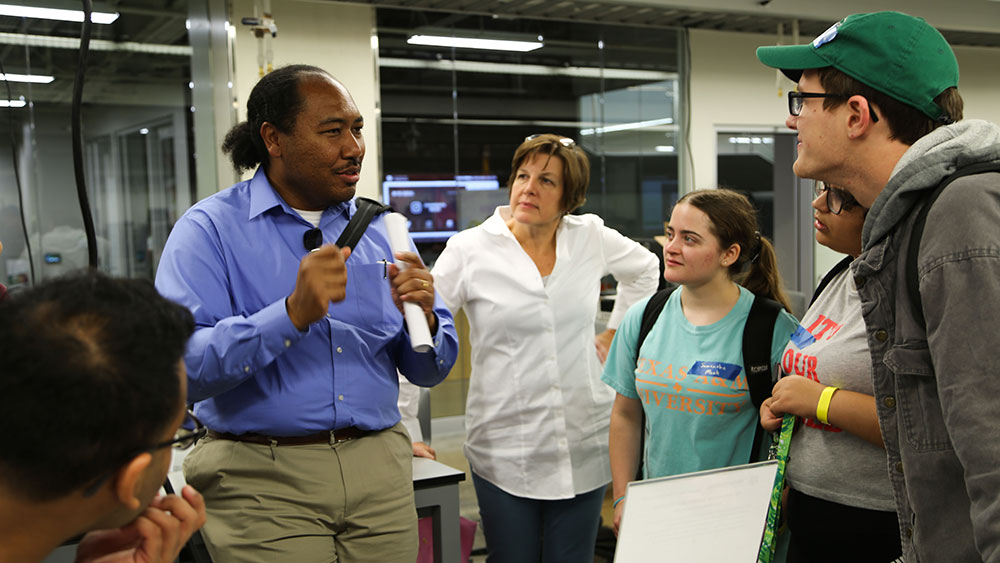
With 48 hours on the clock, 51 engineering students grouped into 10 teams innovated and presented cybersecurity defense measures for the 20 to 50 billion devices estimated to be connected using the "internet of things" by 2020. These proposals were judged by a panel of National Security Agency (NSA) and Texas A&M staff.
In its first student make-a-thon sponsorship, the National Security Agency teamed up with Texas A&M University to tackle cybersecurity issues in Aggies Invent: Internet of Things and Aggies Secure.
“Aggies Invent gave us an opportunity to explore another area of engineering and highlight all our unique skills sets,” said Connor Jakubik, a junior aerospace engineering student.
Aided by NSA mentors, many of whom are former Aggies, the student teams selected and solved real-world challenges detailed by the federal agency. These included such topics as developing methods for evaluating privacy risk of internet of things devices, detecting compromised routers, autonomously monitoring internet of things devices for anomalies and detecting unmanned aerial systems.
“The NSA mentors were some of the most knowledgeable people I’ve ever met,” said Xavier Polisetty, a sophomore engineering student. “After my experience with Aggies Invent, I’m considering an NSA internship.”
From national voting and polling to personal cellphones and tablets, the internet of things connects the world.
With daily uses, such as transferring data on a flash drive or changing a thermostat with a cellphone, to unique research opportunities like the future navigation systems in autonomous vehicles, the internet of things is a network of information sharing.
This world of cyber connectivity is efficient and convenient and opens doors to the future of technology and communication. However, because of the novelty and rapid advancement of the internet of things, there is an overall lack of security to prevent hackers or cyber actors from accessing connected devices and data therein.
“Cybersecurity is a tremendous threat today. It is not a matter of if something needs to be protected, but how it will defend itself,” said Rodney Boehm, director of engineering entrepreneurship at Texas A&M.

At the end of the 48-hour event, team Net 360 claimed first place for their proposal to create a digitized, mixed-reality Network Operating Center. The team included Drew DeHaven, Shrey Shah, Vansh Narula, Connor Jakubik, Patrick Zhong and Xavier Polisetty.
Network Operating Centers are tasked with monitoring every part of a cybernetwork using multiple physical computer screens to assure that it is secure and functional.
With too much data displayed on too many screens, the process of fixing a disruption in the network is hindered by an overflow of information. Once the various nodes and branches are waded through to get to the core issue, be it an outage, anomaly or cyberattack, someone is then manually assigned to handle it.
As the internet of things creates a larger and more complex web of information, the greater the need becomes for a streamlined and efficient way to view and fix networks.
Enter Net 360, a digital Network Operating Center that allows users to view, inspect and correct the nodes of a network with a virtual reality headset.
The team’s interface displays a 3D model of the network that highlights disturbances in the normal data flow and automatically notifies the right team to examine it. This method provides a better way to visualize data that enhances collaboration and easy interaction with the nodes. By allowing networks to be monitored in real time, it also cuts down on the time lost to manually assigning tasks and allows issues to be resolved quicker. This, in turn, saves money for the companies involved.
“The NSA provided us with a set of difficult problems to solve and I am amazed at the solutions our students came up with,” said Boehm. “More importantly, the NSA mentors said that our students impressed them tremendously with their level of knowledge, innovativeness and passion for their projects.”
“Each team spent a lot of time researching the problem, reading papers, finding out how the problem might already have partial solutions and asking the mentors lots of questions,” said Amy Andrews, technical director with workforce support activities at the NSA. “Every piece of information they got helped shape the solutions space. Equally intriguing was that every team presented not only what their solution was, but highlighted the areas they researched and how those items influenced their recommendations.”